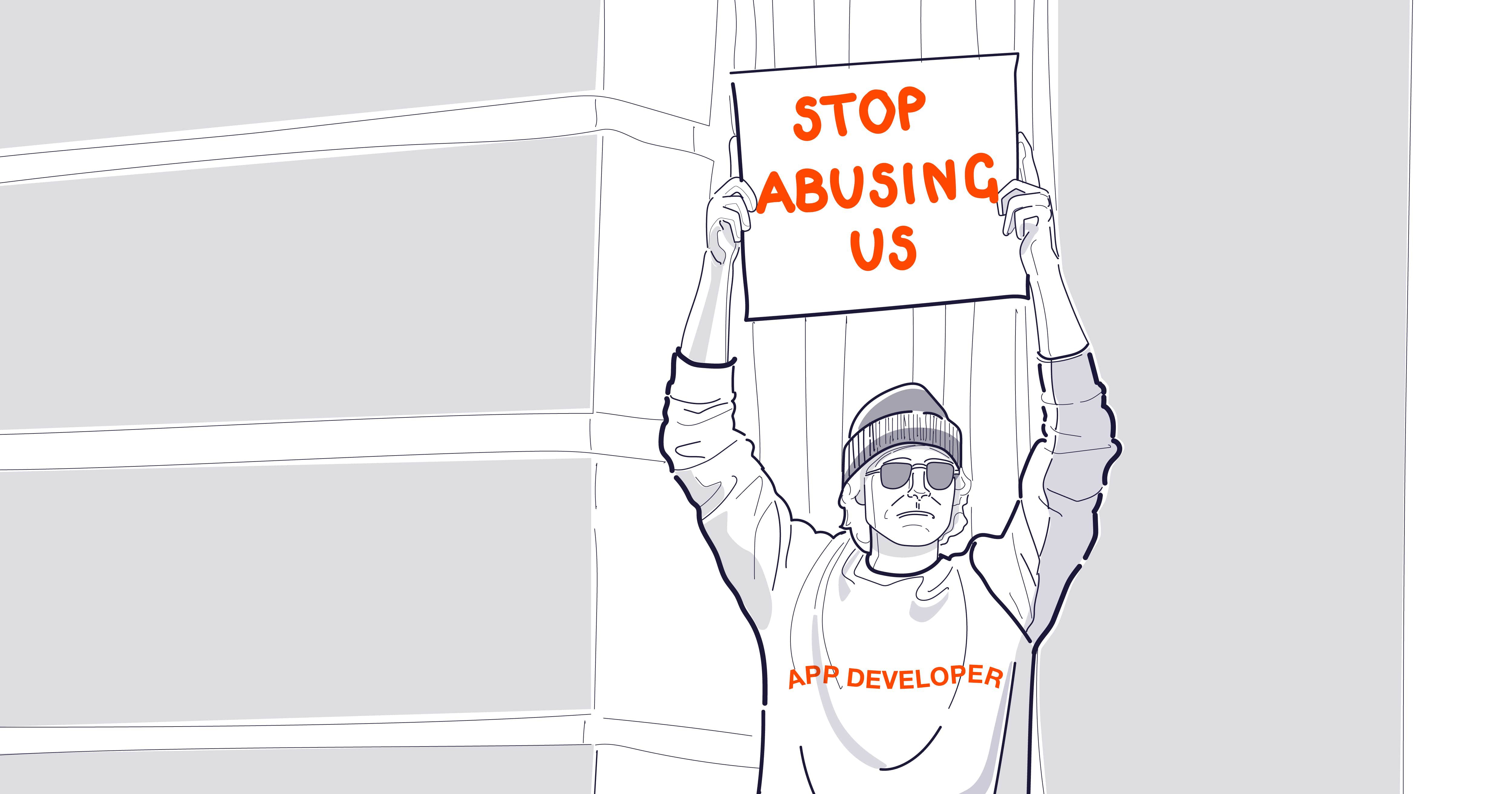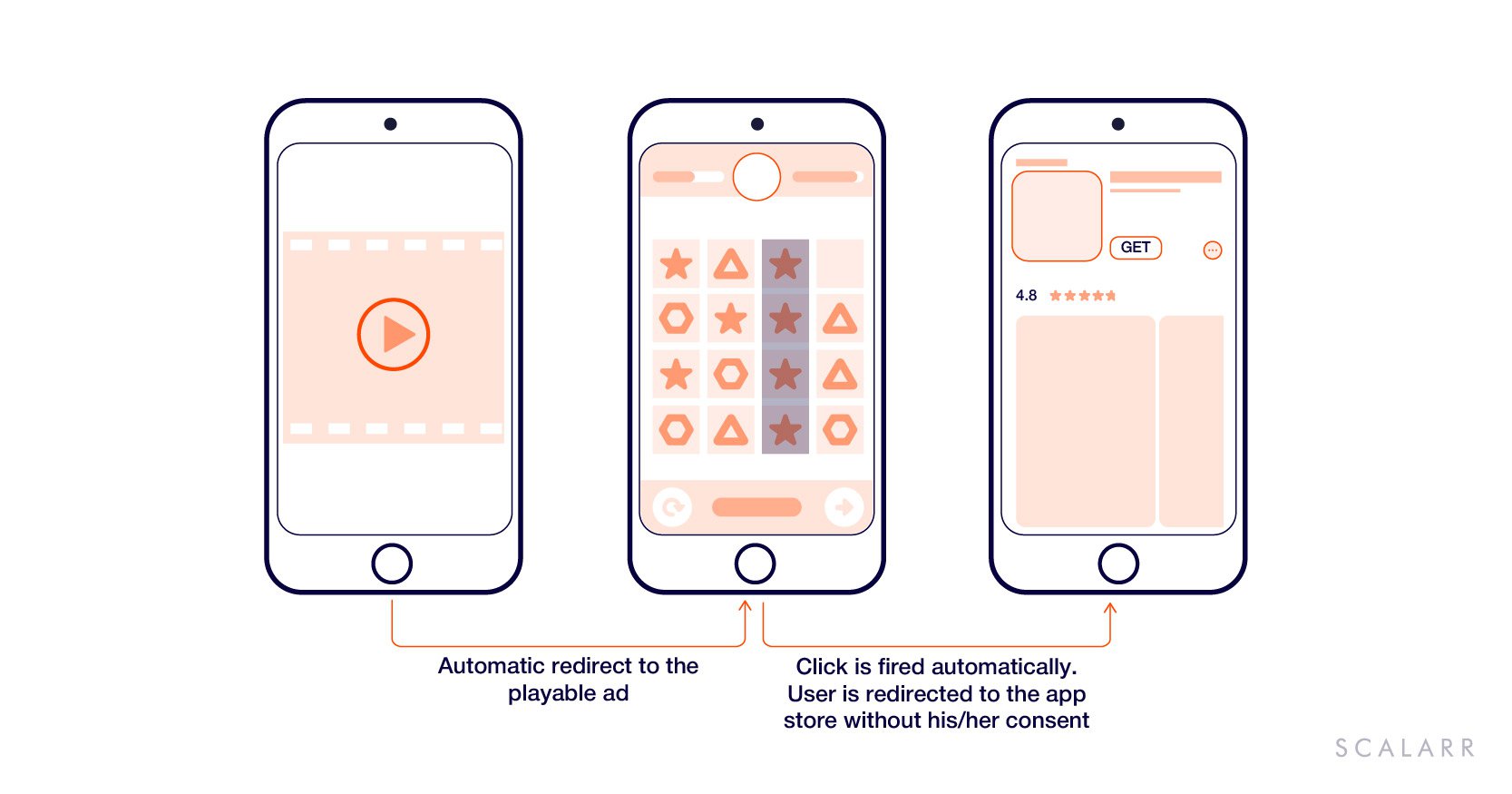
At Scalarr, we take a comprehensive approach to detecting fraud, which means combining proactive research activities and reactive measures. Thus, today we focus on one of the most disturbing signals we’ve observed in the last couple of months in some of our client’s ad campaigns and warn the mobile community.
In this post, we’ll explore the role of a specific kind of ad creatives - ‘auto-clicks’ (playable ads and “StoreKit” ads), which are currently very popular; nonetheless, they have a lot of vulnerabilities which leads to the highest probability of catching fraud. And it’s definitely something to take notice of as nearly 80% of conditionally trusted ad networks and DSPs use these types of formats.
Mechanics of “Auto-Clicks” ads
The mechanics behind “auto-clicks” ads are: a potential user watches a video ad and upon its completion, he/she is automatically redirected to the app page in the store if the user doesn’t show any interest in this game/app. While redirecting the user, the platform fires auto clicks in order to attribute the user if he/she decides, by coincidence, to install the app.
The decision to install an app is directly and solely made by the user. In the case of playable ads, an ad is placed in between the video and forces a redirect to the store page of the app. Essentially, the user interacts with it and is immediately re-addressed to the app page in the store.
‘Auto-clicks’ ad formats are used to redirect the user through a click link to the application store without their consent.

What can go wrong in this scheme and what is hidden behind the reasons of advertising networks to use this ad format to attract users for a client?
1. Extension of the Attribution Window
Traffic providers apply to a 7-days attribution window for a click when it comes to using ‘auto-clicks’ ad formats. In stark contrast, the industry standard is 1-day from the moment the ad is shown.
Evidently, traffic providers ensure more beneficial conditions with this modus operandi, as they get 7 days of attribution instead of the 1-day standard. This leaves the door wide open for a lot of manipulation.
2. Attribution of Organic Users or Users Attracted by Other Ad Networks
Unfortunately, our research shows that at least 35% of all users generated through ‘auto-clicks’ ads should not be attributed to such media sources.
In fact, more than 30% of them have a TTI of more than 24 h. Therefore, a forced redirect through a click link allows ad networks and DSPs to assign organic users to them. And at least 5% of conversions are being re-attributed by applying to such an approach from other sources. Thus, the true CPI cost is severely distorted, and the whole ad campaign could be less than benefited.
Unfortunately, our research shows that at least 35% of all users generated through auto-clicks ad formats should not be attributed to such media sources, as these installations have a TTI of more than 24 hours. This leads to stealing organics and borrowing users from other ad networks and DSPs.
Here’s an example for context: Click attribution has become a key priority, trumping over display attribution. For this scenario, Source A uses auto-clicks ad formats and shows an ad to a user about an app. The user is redirected through a click link to the app’s page. Still, the user does not install the app. After some time, the user notices ads for the same app but in Source B. The user, who hasn’t yet clicked on the ad from Source B, opens the store and installs the app. As a result, the user will be attributed to source A despite the fact that the ad from source B was the latest one before the app was actually installed.
As a matter of fact, using forced redirects and making clicks give sources a guarantee of user attribution. When sources simply show an ad, they don’t have any form of guarantee or protection.
3. High Rates of LAT devices in Clicks
What is LAT? It is a device that has a hidden device identifier, known as IDFA/GAID. Our research shows a very high percentage of LAT devices in clicks behind the clicks from sources that use auto-clicks ad formats, such as the StoreKit format. Actually, it is higher than 60% on average, but in some cases there were more than 90% of these “empty-identifier” devices.
In 60% of all cases where auto-clicks ad formats are used, there are devices with empty identifiers (LAT devices). Some ad campaigns showed more than 90% of these devices behind clicks.
In this regard, there is no way to be certain about the percentage of users that were intercepted from other sources via auto-clicks ad formats, but the number is clearly more than the mere 5%.
It’s relatively safe to assume the percentage of LAT devices is made on purpose to hide the real type of advertising and to not have the option to determine the real percentage of users that can be acquired via auto-clicks ad formats.
4. Low Conversion Rates
Most users don’t enjoy being forcefully redirected to the app store. This can be seen in the dramatically low CR values in sources with auto-clicks ad formats, which is a clear indication of users being unhappy with the situation. In fact, some sub-publishers have CRs that only hit 0.08% or lower.
Using auto-clicks ad formats creates a negative background on your app since users are being forced to install it.
5. Long TTI and Mixes
Having a long TTI distribution can be a clear sign of a click spam pattern. The user does not 100% decide whether to click on the advertisement or not. Instead, the click is performed by ad networks and the TTI is prolonged significantly.
In this scenario, there is a real risk of sources adding click spam schemes to the traffic generated through auto-clicks ad formats without being noticed. In fact, auto-clicks ad formats create the ideal conditions for:
- Low CRs.
- Click Spam Distribution of TTI.
- High % of LAT devices.
To sum up…
Life is full of risks and to survive, it’s important to remain realistic and take each detail into account. Surely, our colleagues who are dedicated to investigating fraud will agree that the ad campaigns covered in this post need to be carefully reviewed by advertisers since:
- The attribution window of auto-clicks ad formats is purposely extended which can lead to organics’ stealing as well as attributing users that belong to other ad networks.
- Auto-clicks ad formats enable traffic providers to inject click spam, both partially and fully.
- With forced redirects, users are left with a negative experience of the app.
Simply put, auto-clicks ad formats need to be taken more seriously when investigating for attribution fraud. Pointedly, some of our clients have expressed their concerns whenever these types of ad formats are involved and it's in everyone's best interests to keep a close look and not compromise the safety of the app.
The only solution for mobile advertisers is to partner with anti-fraud tools that make use of powerful and intelligent technologies such as machine...
The road to Scalarr's foundation was paved with challenges and opportunities and in this in-depth conversation, you'll learn the story of Scalarr f...